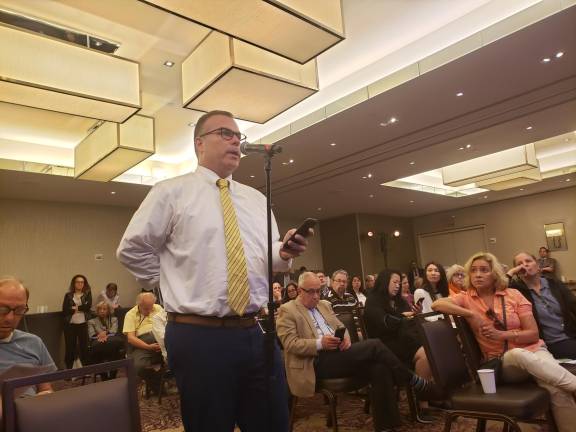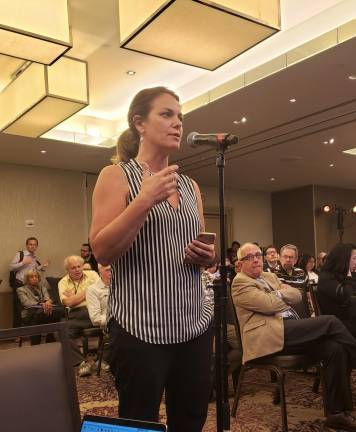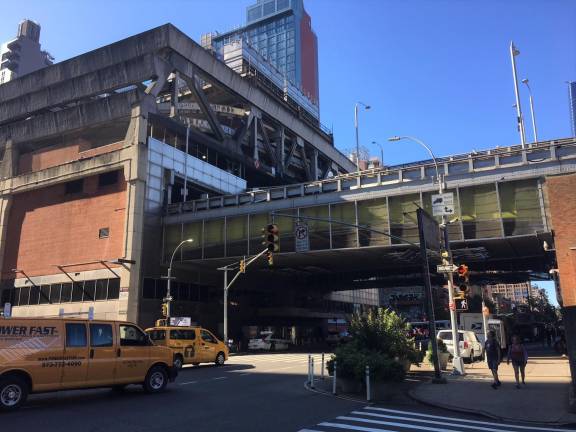'Please Don't Blow It'
New Yorkers weigh in on the Port Authority's plans for the future of the Eighth Avenue bus terminal



The nation’s largest bus terminal causes terrible traffic congestion and poor air quality in Midtown Manhattan and needs to be improved or moved, a stream of concerned New Yorkers said last week at a public hearing about the future of the Port Authority Bus Terminal (PABT).
The hearing, held at the Westin Hotel Times Square on West 43rd Street, was an opportunity for residents to weigh in on a trio of options proposed for the transformation of the terminal.
The overall goal of the project, which is expected to cost $7.5 to $10 billion and be completed by 2030, is to increase capacity, reduce on-street congestion, improve bus storage and staging to reduce bus idling, and improve bus network reliability.
Quality of Life
Millie Torelli, a member of the Hell’s Kitchen Democrats, said that renovating the bus terminal is long overdue. “The congestion is worse than just a few junkies,” she said. “I’m especially concerned that everyone’s quality of life is being violated by all these buses.”
Torelli is in favor of relocating the terminal to the Jacob Javits Center, one of the three options described in a planning-level scoping document released in May by the Port Authority of New York and New Jersey.
As an asthmatic, Torelli hopes that whatever the Port Authority decides to do will improve the air quality in the city. “Isn’t that my right, to breathe?” she said. “The amount of buses that illegally idle is unbelievable. There will come a day when tourists won’t want to come here.”
Pastor Tiffany Triplett Henkel, of the Hell’s Kitchen South Coalition, said she has spent the last two years working with stakeholders to come up with a plan for the terminal. Like Torelli and others, Henkel said the idling buses are a major problem. “Our community is affected by the many buses at our curbside,” Henkel said.
According to Henkel, Hell’s Kitchen has the third worst air quality in all of New York City. She stressed that any improvements to the PABT must involve an enclosed air filtration system.
A Rare Opportunity
Steven O’ Brien, who has lived in Hell’s Kitchen for 25 years, is glad the aging bus terminal is finally being addressed. “An investment in a public project like this comes around every 50 years or so,” he said, “so please don’t blow it. Please do all you can to create a much better customer experience.”
Elected officials also spoke at the meeting. Assembly Member Richard Gottfried gave testimony on behalf of himself, Congressman Jerrold Nadler, Council Speaker Corey Johnson, Senator Brad Hoylman and Assembly Member Linda Rosenthal. They all support the option of rebuilding the bus terminal in-place on the existing site.
“Building in place allows the PABT to take advantage of existing tunnel and mass transit infrastructure,” Gottfried said. “We support this alternative with the caveat that it integrates a facility that includes bus parking and staging, and absorbs all intercity, long-distance, commuter and tourist buses currently operating curbside.”
Gottfried went on to explain some of the complications that he and his colleagues believe rule out the Javits Center option, including “how it interacts with the current Lincoln Tunnel infrastructure, the West Side Highway and the Hudson River Greenway.”
The Manhattan hearing fell within the Port Authority’s 120-day period to solicit comment from the public. The first two such meetings, one in each state, were held July 10. The deadline for public comment is September 18.
The existing terminal was built in 1950 and expanded in 1981. The terminal now serves an estimated 260,000 passenger trips on weekdays, or 23 percent of trans-Hudson trips entering or exiting Manhattan’s central business district, and 8,000 bus movements. Demand is expected to increase by 30 percent, with up to 337,000 weekday passenger trips by 2040.
While the process to build a new bus terminal is continuing, the Port Authority has undertaken an aggressive $110 million Quality of Commute program to enhance the customer experience at the existing facility. The initiatives include new and enhanced retail, new bathrooms, new doors at the terminal’s Eighth Avenue entrance, new lighting and ceiling and improved elevators and escalators. The Port Authority also has partnered with bus operators on operational changes that have reduced crowding within the terminal and relieved congestion caused by buses on nearby streets.